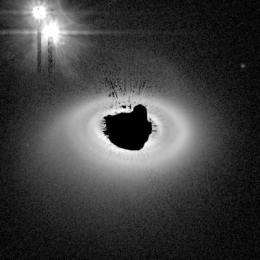Destroyer of worlds

(PhysOrg.com) -- Astronomers, in addition to discovering extrasolar planets (about 500 of them currently have known orbital parameters), have detected excess, warm infrared dust emission around many stars.
This emission, first spotted by the Infrared Astronomy Satellite (IRAS) in the 1980's, appears to come from small particles in disks around the stars that might be in the early stages of planet formation. In some cases, models of the dust temperature and spatial distribution suggest that the disk has a gap, perhaps excavated by a planet at the appropriate orbital distance.
Since planets are made from circumstellar materials, the dust rings in very young systems could be remnants of the planet building process. That dust, however, is thought to disappear after only a few hundred million years; when it is seen in older stellar systems, astronomers surmise, it must have been somehow replenished. One popular scenario is that planets or asteroids in the system collide and fragment, thereby generating the dust.
Very old stars, however, (ones that are about a billion years old or more, the sun being about 4.5 billion years old) should not have warm dust according to this reasoning. Those stellar systems should have stabilized, and the time for such collisions should have long past.
It is a problem, then, that warm dust is seen around some very old stars. Moreover, since any newly made dust will also rapidly dissipate, there must be some mechanism that regularly regenerates it. Astronomers trying to piece together a coherent history of planet formation and evolution are trying to figure out the answers to these questions.
SAO astronomers Marco Matranga, Jeremy Drake, Vinay Kashyap, and Research Associate Massimo Marengo, together with a colleague, suggest an answer for one set of stars in this puzzle.
They used the Spitzer Space Telescope to study the excess warm infrared emission around three evolved stellar systems, each of which is a binary with two stars in close orbits. The measured infrared emission can be as much as 1.9% of the total emission of these systems.
They note that the binary stars are known to be magnetically active (surface sun-spots are detected in their atmosphere), and they argue that magnetic fields interacting with winds can induce changes in the binary stars' orbits. These changes can in turn disrupt the overall stability of the system and trigger new collisions between bodies in orbit around the stars, with the consequent production of new dust.
In effect, these binary stars are destroyers of the worlds in orbit around them, worlds that otherwise had survived for a billion years. Besides helping to resolve one long-standing puzzle, the new paper points to the complex nature of stellar planetary system, and the importance of multi-wavelength data analyses.
Provided by Harvard-Smithsonian Center for Astrophysics


















